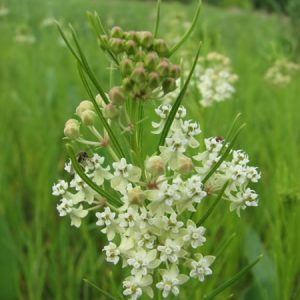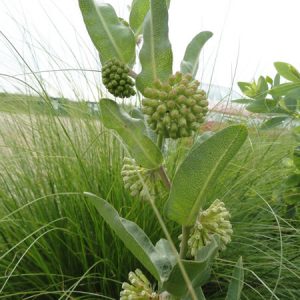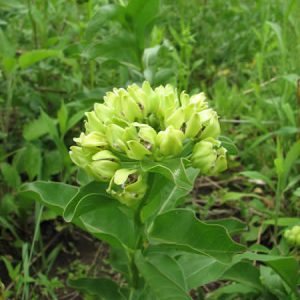
Asclepias tuberosa – Hello Yellow Milkweed
‘Hello Yellow’ is a cheerful cultivar of Asclepias tuberosa (Butterfly Weed) featuring bright yellow flower clusters. Native to Michigan and widely distributed throughout the United States, Butterfly Weed is a vigorous milkweed variety that produces clusters of flowers that bloom from early summer until frost. In addition to being a nectar favorite for butterflies, hummingbirds, bees, and other beneficial insects are drawn to this long blooming Milkweed. Like most Asclepias, this plant is happiest in well-drained soils, but it will put up with a lot of hardship, including poor, dry soil and long periods of drought. It needs full sun and plenty of it to reach its peak performance.
Available – May 2017
Grown in 4.5″ square pot.
All of our plants are grown without the use of harmful pesticides and are safe for developing larvae.

Asclepias verticillata – Whorled Milkweed
Asclepias verticillata
Asclepias verticillata Whorled Milkweed is a Michigan Native and one of the most broadly distributed of all milkweeds in the United States . It likes dry sandy, clayey or rocky soil in sun or part shade and can be found growing in a variety of environments from hill prairies to woodland openings. It is listed as rare or threatened in some of its northeastern range.
This petite milkweed blooms later in the year than most milkweed and is a common late season host plant for Monarch larvae. Flowers are white to greenish white and attract many insects including butterflies and bees. It is deer and rabbit-resistant. Also known as Horsetail Milkweed.
*Available late May.
Grown in 4.5″ square pot.
All of our plants are grown without the use of harmful pesticides and are safe for developing larvae.

Asclepias viridiflora – Short Green Milkweed
Asclepias viridiflora Short Green Milkweed is a Michigan native milkweed. While somewhat rare it has an extensive range throughout the United States. The plant matures to 1-3′ in height making it a nice choice for borders. Short Green Milkweed blooms during early summer with blooms lasting about three weeks. Flowers are light green to green and as the plant matures the flowers begin to turn yellowish green or purplish green. It prefers full to partial sun and grows in a variety of soils but prefers dry-mesic to mesic. Habitats include openings in upland forests that are rocky or sandy; upland black soil prairies, sand prairies, gravel prairies, and hill prairies; barrens, limestone glades, and sand dunes; and abandoned fields.
The flowers attract bumblebees and butterflies. Also known as Green Milkweed, Green Comet Milkweed, Green Antelopehorn Milkweed, Green-Flowered Milkweed.

Asclepias viridis – Spider Milkweed
Spider Milkweed is also commonly known as Green Antelopehorn Milkweed. In Texas, it is quite common and is considered an important food source for the Monarchs as they start their spring migration northward. Spider Milkweed has a native range of Texas north to Nebraska and eastward as far as West Virginia and South Carolina. It can be found along roadsides, ditches, prairies, open areas, and other areas with little vegetative competition. This species tends to be short (12 inches) with multiple stems emerging from the root crown of mature plants. Taller, more erect plants, usually with one or a few stems, can be found in moist prairies. Spider Milkweed features rose-white flowers surrounded by green that form in showy umbellated clusters, often one per plant.
Available – May 2017
